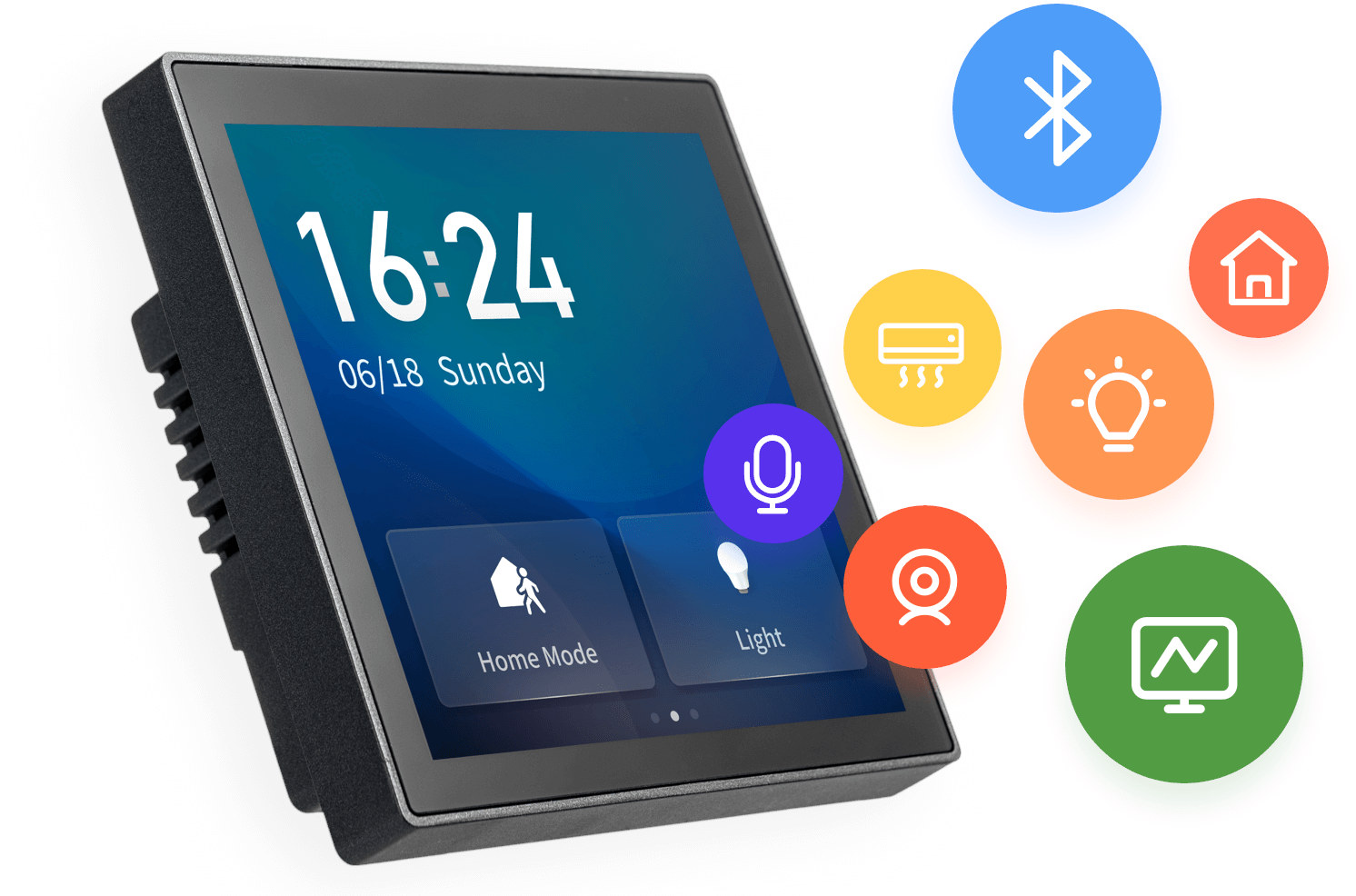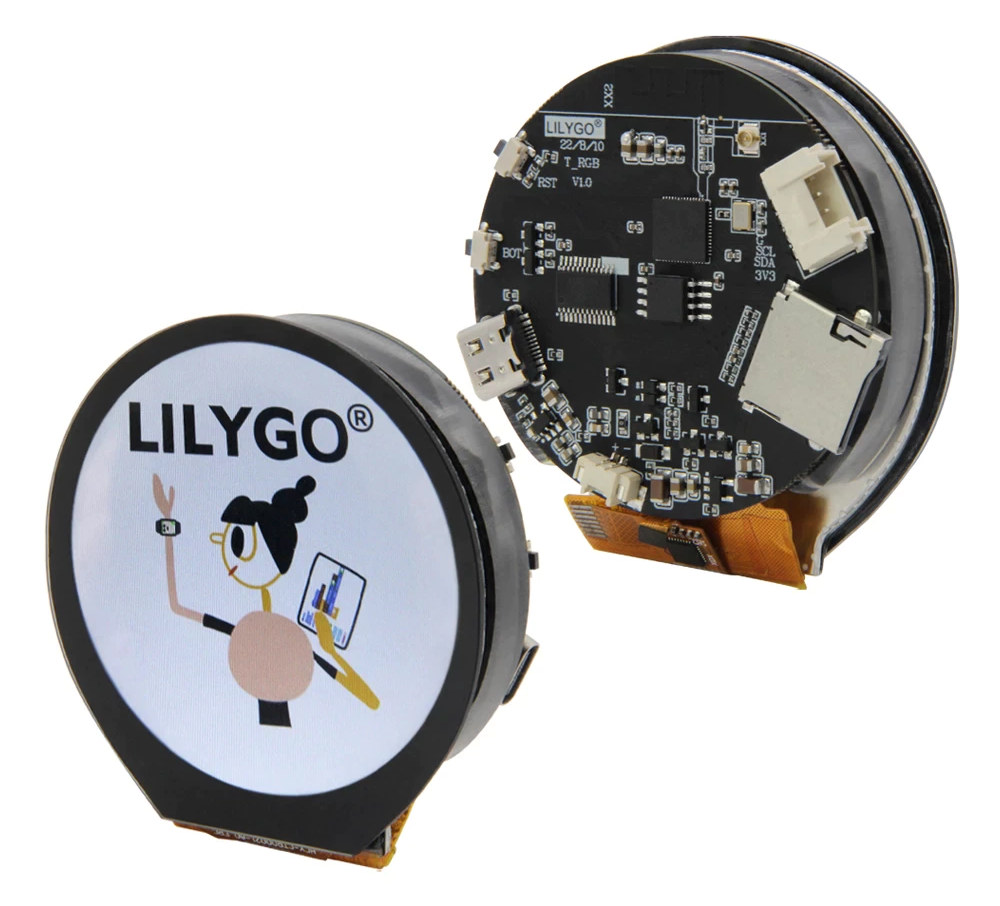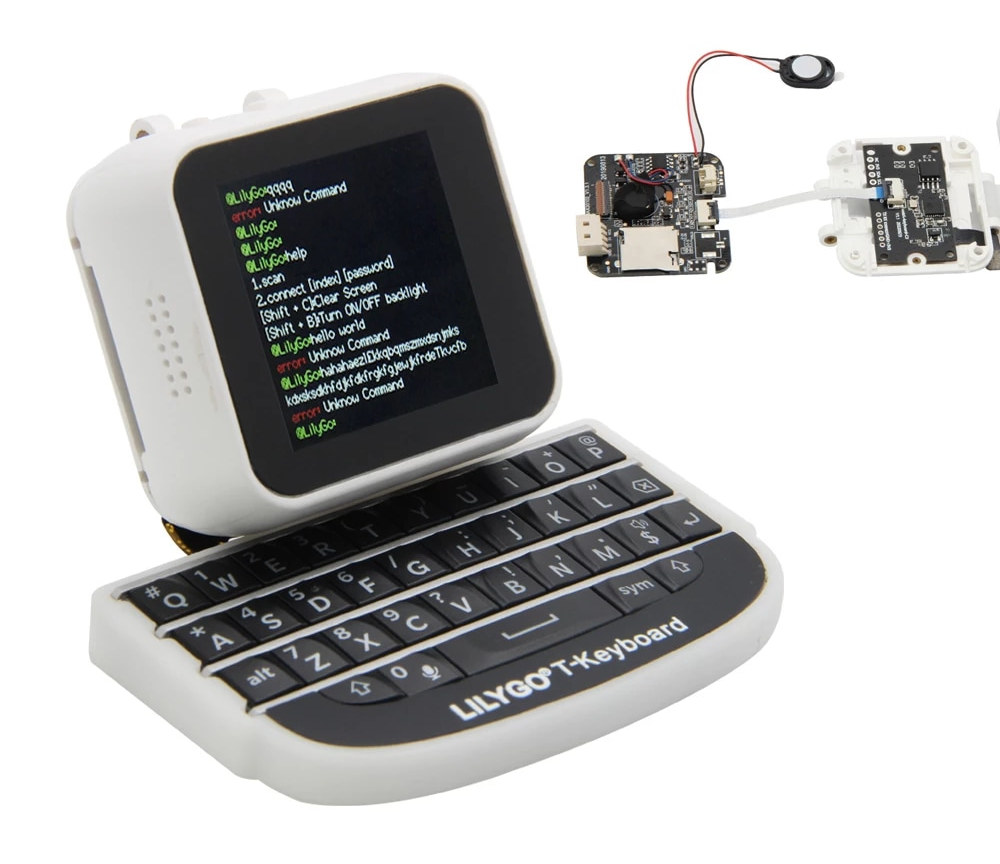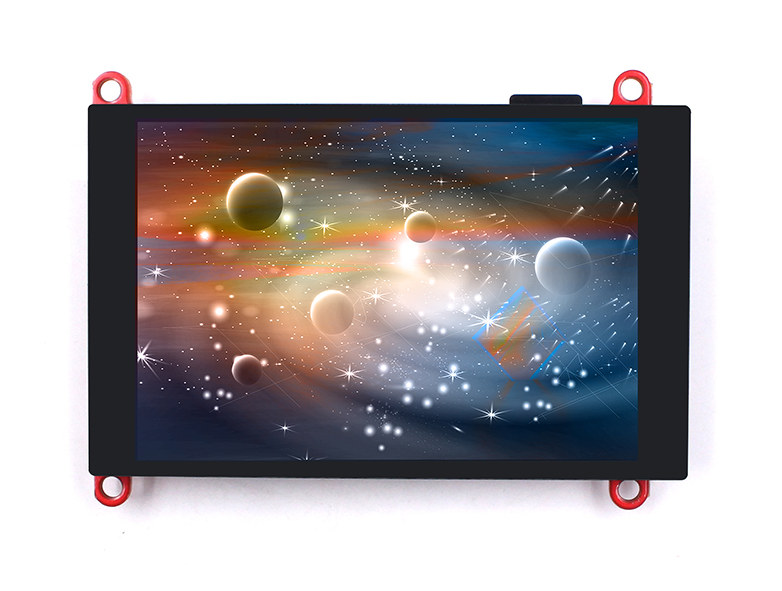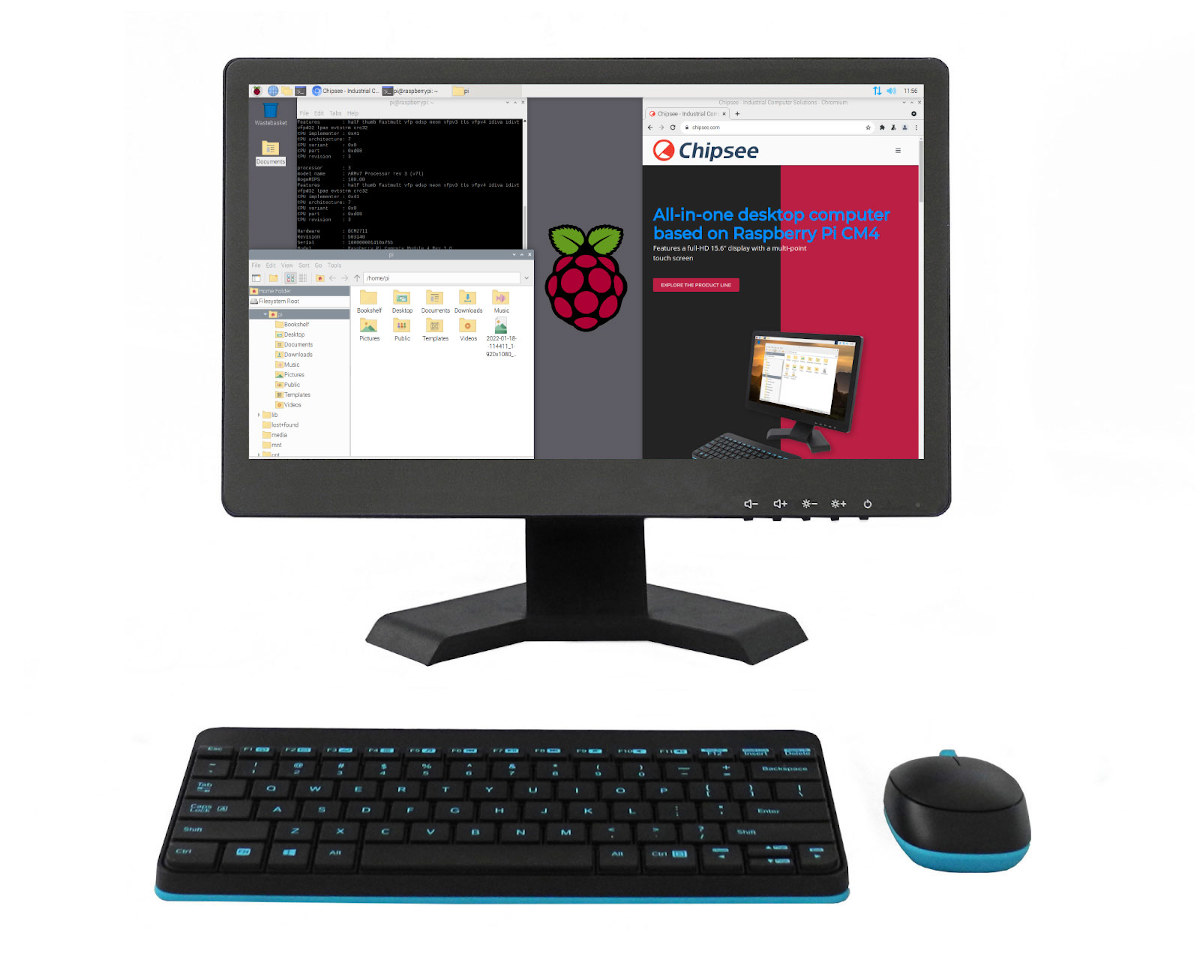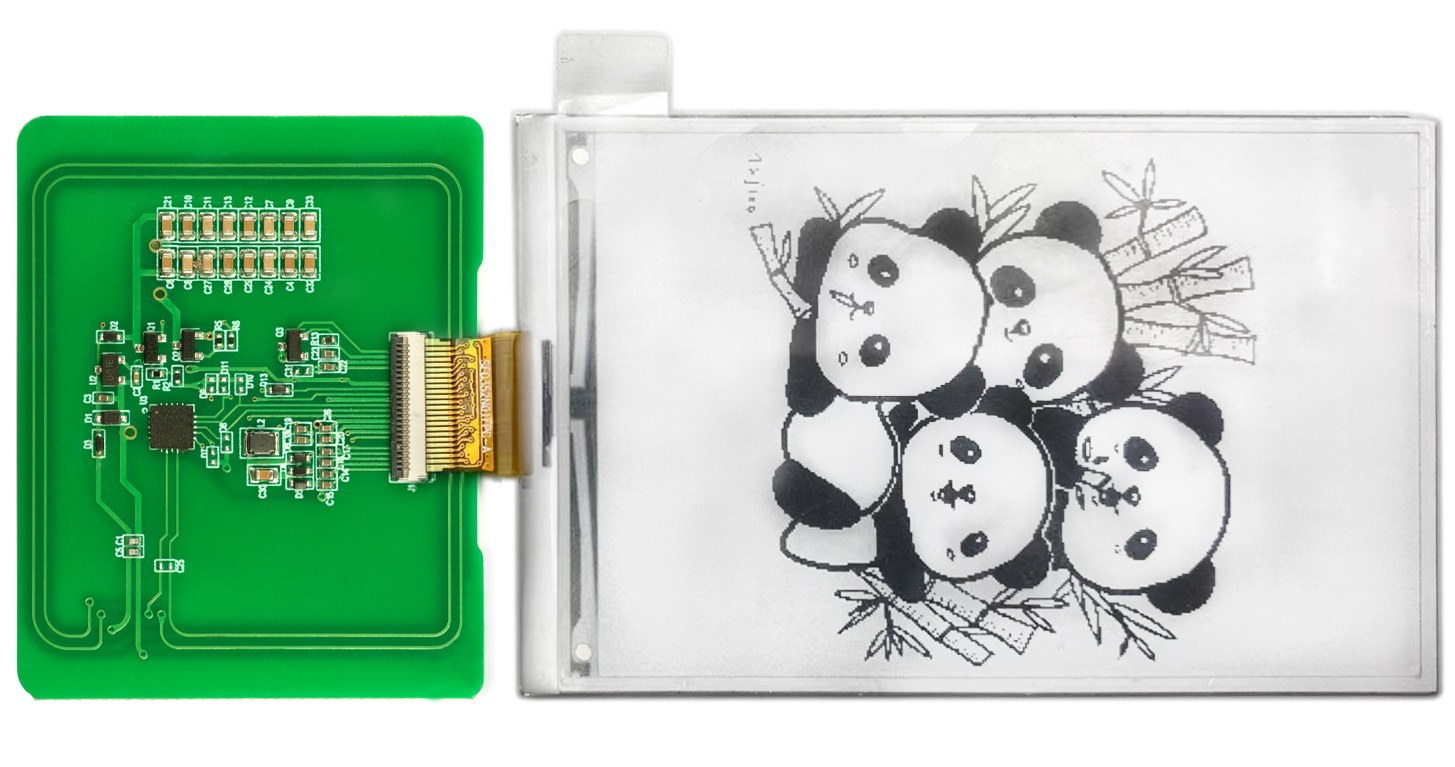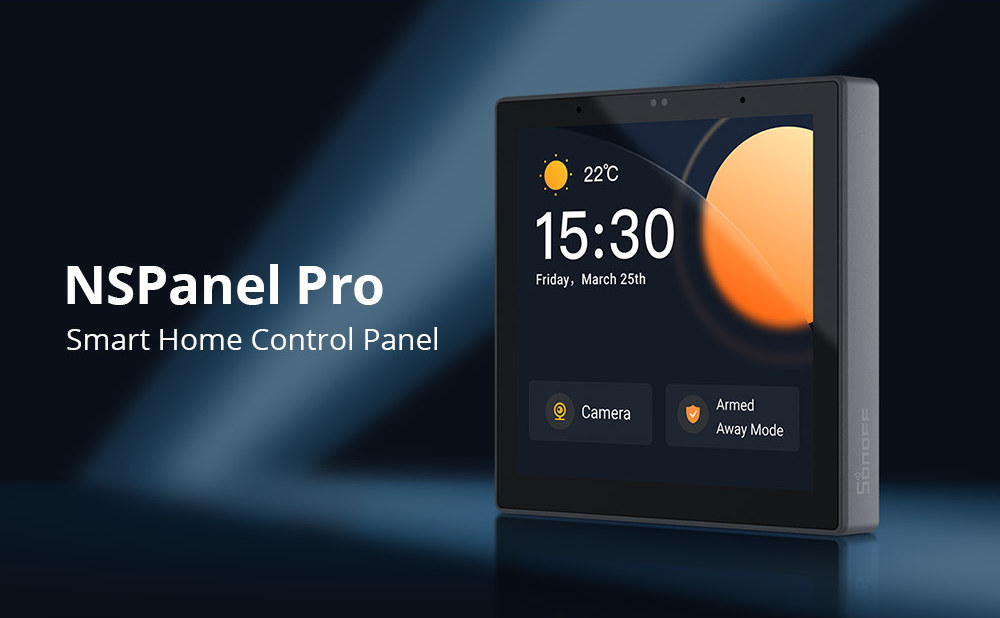Tuya T6E is a 4-inch control panel with a touchscreen running Android 8.1 on Rockchip PX30, WiFi, Bluetooth, and Zigbee, and designed to be wall-mounted for home automation and other HMI applications. It looks fairly similar to the ITEAD NSPanel Pro introduced last month, for Tuya’s “Central Control System” (CSS) appears to be mostly designed for OEMs who want to roll their own products with custom firmware. Tuya T6E specifications (details vary depending on OEM requirements): SoC – Rockchip PX30 quad-core Arm Cortex-A35 processor @ up to 1.5GHz with Mali-G31 MP2 GPU System Memory – 1GB, 2GB, or 4GB RAM Storage – 4GB to 8GB eMMC flash Display – 4-inch 480×480 IPS screen with 5-point capacitive touch Audio Dual-array microphone with noise reduction 1 Watt speaker Connectivity 10/100Mbps Ethernet RJ45 port 2.4 GHz 802.11b/g/n Wi-Fi 4 Bluetooth LE 4.2 and Bluetooth Mesh (Tuya SigMesh) Zigbee 3.0 gateway based on Tuya […]
LILYGO T-RGB round color touch display is powered by ESP32-S3R8 wireless microcontroller
LILYGO T-RGB is a wireless 2.1-inch round color touchscreen display based on ESP32-S3R8 dual-core microcontroller with WiFi 4 and Bluetooth 5.0 connectivity, 8MB PSRAM, and 16MB flash storage. The device also includes a microSD card socket for data storage and a Grove I2C connector for expansion and supports LiPo battery power. The company also says it can be charged through USB, so the board must include a battery charging circuit contrary to some other boards from LILYGO. LILYGO T-RGB specifications: SoC – Espressif ESP32-S3R8 dual-core Tensilica LX7 microcontroller up to 240 MHz with vector instructions for AI acceleration, 8MB PSRAM, WiFi 4 and Bluetooth 5.0 LE + Mesh connectivity Storage – 16MB SPI flash, MicroSD card socket Display – 2.1-inch round 18-bit RGB color IPS TFT display with 480×480 resolution (ST7701S SPI controller), touchscreen panel USB – USB Type-C port for power and programming Expansion – Grove I2C connector Misc […]
T-Embed is a battery powered WiFi controller with display and rotary encoder
LilyGo has launched yet another product based on the ESP32 family of microcontrollers with the T-Embed WiFi IoT controller powered by an ESP32-S3 dual-core processor, equipped with a color display and a rotary encoder, and powered by a battery. The device is programmable and can be used to control Smart Home and IoT devices connected over WiFi or Bluetooth. It also integrates a microphone and speaker, a microSD card for data logging, as well as a Grove connector and an 8-pin GPIO header for expansion. T-Embed specifications: Wireless module – ESP32-S3-WROOM-1 module with an ESP32-S3 dual-core Xtensa LX7 processor with WiFi 4 and Bluetooth 5.0 connectivity, 4 to 16MB QSPI flash, up to 8MB PSRAM, PCB antenna; (Note it’s unclear which exact version is used) Storage – MicroSD card socket Display – 1.9-inch IPS color TFT LCD with 320 x 170 resolution (ST7789 driver), 350 Cd/m2 brightness Audio – 2x […]
T-Watch-Keyboard-C3 with ESP32 “watch”, ESP32-C3 keyboard looks like a miniature PC replica
T-Watch-Keyboard-C3 is a device that looks like a miniature PC replica comprised of an ESP32-C3 powered keyboard, and the TTGO T-Watch ESP32 programmable device with a 1.54-inch touchscreen display. The LilyGo TTGO T-Watch ESP32 programmable touchscreen display has been around for a while, and the company used to provide an accessory keyboard based on Microchip ATSAM20 Cortex-M0+ microcontroller that has now been replaced with ESP32-C3 WiFi and Bluetooth RISC-V microcontroller to create the T-Watch-Keyboard-C3 devices pictured below. T-Watch-Keyboard-C3 specifications: TTGO T-Watch MCU – ESP32-D0WDQ6 dual-core microcontroller @ 240 MHz with WiFi 4 and Bluetooth 4.x with 520KB SRAM Memory – 8MB PSRAM Storage – 16MB QSPI flash Display – 1.54-inch LCD screen USB – 1x USB Type-C port for power and programming via CP2104 USB to TTL chip Sensor – 3-axis accelerometer Misc – Power button, RTC Dimensions – 40 x 38 x 20 mm Weight – 43.19 grams […]
Makerfabs 3.5-inch TFT touchscreen display features ESP32-S3 SoC
Makerfabs has launched a 3.5-inch TFT touchscreen display with built-in WiFi and Bluetooth connectivity through an ESP32-S3 dual-core Tensilica LX7 microcontroller clocked at 240 MHz with vector instructions for AI acceleration. This display offers a 320×480 resolution through the ILI9488 LCD driver, uses a 16-bit parallel interface for communication with ESP32-S3 clocked at up to 20 Mhz making it suitable for smooth graphics user interface, and the company also claims it is smooth enough for video displays, but more on that later. Specifications: Wireless module – ESP32-S3-WROOM-1-N16R2 with Espressif Systems ESP32-S3 dual-core Tensilica LX7 @ up to 240 MHz with vector instructions for AI acceleration, 512KB RAM, 2.4 GHz WiFi 4 and Bluetooth 5.0 LE with support for long-range, up to 2Mbps data rate, mesh networking 16MB QSPI flash 2MB PSRAM PCB antenna Storage – MicroSD card socket Display – 3.5-inch color TFT LCD with 480×320 resolution, 16-bit parallel interface […]
Chipsee AIO-CM4-156 – A 15.6-inch industrial All-in-One computer with Raspberry Pi CM4
Chipsee AIO-CM4-156 is an industrial All-in-One computer powered by a Raspberry Pi CM4 module and equipped with a 15.6-inch capacitive touchscreen display with 1920×1080 resolution. The new panel PC builds upon the earlier AIO-CM4-101 model with a 10.1-inch touchscreen display and besides the larger and higher resolution 15.6-inch Full HD display, it also adds support for an optional 250GB Sandisk NVMe SSD and a 2mm protective “armoplated” Glass. Since as far as I know, “armoplated” is not a word, they may refer to armored/toughened glass instead. AIO-CM4-156 specifications: SoM – Raspberry Pi CM4 with Broadcom BCM2711 quad-core Cortex-A72 processor at 1.5 GHz, up to 8GB RAM, up to 32GB eMMC flash Storage MicroSD card slot for boot (only used with CM4 Lite) M.2 NVMe socket for an optional 250GB SSD drive Display – 15.6-inch IPS LCD with 1920×1080 resolution, optional 10-point capacitive touchscreen, 250 cd/m2 brightness, 2mm protective armored glass […]
HiPo batteryless NFC-powered 3.52-inch e-Paper display also comes with an SPI interface (Crowdfunding)
HiPo is a 3.52-inch black and white e-Paper Display that can be updated through NFC without the need for external power and offers an alternative to the 4.2-inch and 7.5-inch NFC-powered e-Paper displays from Wareshare that also operate without battery only using the data and power from NFC to update the image. Alternatively, Guangdong SID Technology’s HiPo display can also be connected to an SPI adapter board allowing the users to connect it to an STM32 board provided by the company, but it could also be used with Arduino boards, ESP8266 & ESP32 hardware platforms, Raspberry Pi SBCs and MCU boards, or any platform with an SPI interface. HiPo specifications: Controller – Ultrachip UC8251 all-in-one driver IC with timing controller for E-tag applications Display 3.52-inch B&W e-Paper display with 360 x 240 resolution (model name: SE0352N01-MNG-A0) 3 seconds refresh time On-chip display RAM White reflectance above 30% Contrast ratio above […]
SONOFF NSPanel Pro Android control panel doubles as WiFi & Zigbee Smart Home gateway
ITEAD has introduced the SONOFF NSPanel Pro Smart Home control panel running Android 8.1 on a Rockchip PX30 quad-core Cortex-A35 processor and acting as a Smart Home gateway thanks to an 802.15.4 radio for Zigbee 3.0, and 2.4 GHz 802.11b WiFi for connectivity. The NSPanel Pro follows the ESP32-powered SONOFF NSPanel introduced just last year but offers much more flexibility with Android, 2GB RAM, 8GB eMMC flash, and also offers a slightly larger 3.95-inch capacitive touchscreen display with 480×480 resolution. SONOFF NSPanel Pro specifications: SoC – Rockchip PX30 quad-core Cortex-A35 processor with Arm Mali-G31 GPU System Memory – 2GB DDR3 Storage – 8GB eMMC 5.1 flash Display – 3.95-inch capacitive touchscreen color TFT display with 480×480 resolution Audio – 1W speaker, digital microphone for two-way communication (intercom) Connectivity 802.15.4 radio with Zigbee 3.0 support. Matter and BLE Mesh scheduled for 2023 2.4 GHz 802.11b WiFi Sensor – Light sensor for […]


